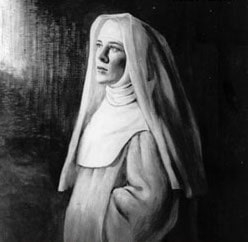
(L to R): Alexander Kirkland, Donald Meek, and F. Cowles Strickland in rehearsal for Rip Van Winkle, 1929.
The first directors of The Berkshire Playhouse were recruited by Walter L. Clark, who bought the Playhouse (formerly known as the Stockbridge Casino) for $1.00 and instituted the Three Arts Society in order to create a new theatre in Stockbridge. During his search for a Director, Mr. Clark was told of Alexander Kirkland, a young actor who had recently been a part of Eva Le Galliene’s Civic Repertory Company.

According to a 1930 article in Heart of the Berkshires, “Kirkland immediately fell in with the plans, on the condition that he could find a partner who would share the executive responsibility and direct the productions.” This partner would be F. Cowles Strickland, a recent graduate of the Yale School of Drama. (Pictured to the right: Alexander Kirkland and Edith Barrett in Romeo and Juliet, 1930, Berkshire Playhouse.)
Alexander Kirkland and F. Cowles Strickland co-directed the theatre from 1928—1930, at which point Kirkland left to pursue other opportunities, both on stage and screen. Kirkland and Strickland were keystones to the early success and longevity of the theatre.
Alexander Kirkland
 Alexander Kirkland (pictured to the left) was born in Mexico City in 1901. He attended the Taft School in Connecticut and the University of Virginia. His theatre career began at the Hedgerow Theatre in Pennsylvania. He would eventually join Eva Le Galliene’s Repertory Company, and toured with their production of The Cradle Song. Civic Repertory Company, and toured with their production of The Cradle Song.
Alexander Kirkland (pictured to the left) was born in Mexico City in 1901. He attended the Taft School in Connecticut and the University of Virginia. His theatre career began at the Hedgerow Theatre in Pennsylvania. He would eventually join Eva Le Galliene’s Repertory Company, and toured with their production of The Cradle Song. Civic Repertory Company, and toured with their production of The Cradle Song.
It was shortly after this that Kirkland began his time with the Berkshire Playhouse. Though he left his role as Co-Director in 1930, he would come back in later seasons to appear in plays. His journey after the Playhouse led him to Hollywood and New York, where he starred with Tallulah Bankhead in the 1931 film Tarnished Lady. He would go on to appear numerous times on Broadway.

Though a prolific actor, Kirkland was also a writer who had short stories published in national magazines throughout his early acting career. In the 1950s, he embraced his literary talent and became a writer and lecturer, as well as the proprietor of an art gallery. He moved back to Guernavaca, Mexico, where he lived until his death in 1986.(Pictured to the right: Alexander Kirkland and Zita Johann in The Lake, 1930, Berkshire Playhouse.)
F. Cowles Strickland
 F. Cowles Strickland worked as the Co-Director, and then Director of the Playhouse until 1934. During his tenure he founded the Berkshire Playhouse Drama School and undertook ambitious plays by such playwrights as George Bernard Shaw, Eugene O’Neill, and Shakespeare. During his final season with the theatre, he introduced a repertory style to the theatre’s summer offerings. style to the theatre’s summer offerings.
F. Cowles Strickland worked as the Co-Director, and then Director of the Playhouse until 1934. During his tenure he founded the Berkshire Playhouse Drama School and undertook ambitious plays by such playwrights as George Bernard Shaw, Eugene O’Neill, and Shakespeare. During his final season with the theatre, he introduced a repertory style to the theatre’s summer offerings. style to the theatre’s summer offerings.
After he left the Playhouse in the capable hands of William Miles, he went on to an illustrious academic career. He was the Drama Director of the Gilbert and Sullivan Club at Wesleyan until 1938. He then went on to an impressive 17-year career at Stanford University. He instituted Stanford’s Artists in Residence program and in 1956 he wrote The Technique of Acting, in which he explored the various techniques used in the craft of acting. Later, He went on to become the first American director of the Finnish National Theater. He was a Professor of Drama at American University until his death in 1971.


